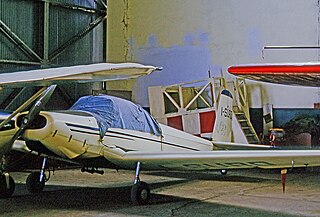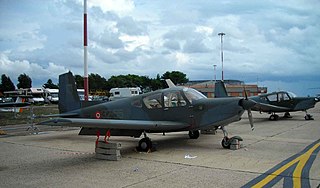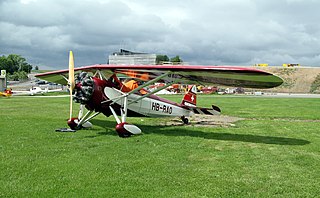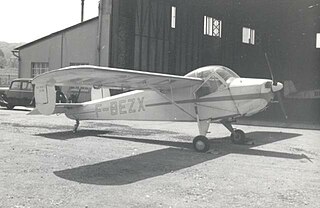| B.60 Mercurey | |
|---|---|
 | |
| Role | Civil utility aircraft |
| National origin | France |
| Manufacturer | Boisavia |
| First flight | 3 April 1949 |
| Number built | 46 |
The Boisavia B.60 Mercurey was a series of four-seat light aircraft developed in France shortly after World War II.
| B.60 Mercurey | |
|---|---|
 | |
| Role | Civil utility aircraft |
| National origin | France |
| Manufacturer | Boisavia |
| First flight | 3 April 1949 |
| Number built | 46 |
The Boisavia B.60 Mercurey was a series of four-seat light aircraft developed in France shortly after World War II.

The Mercurey was a conventional high-wing braced monoplane with fixed tailwheel undercarriage. It was built in small numbers and found use in the normal general aviation roles of tourer, trainer, agricultural aircraft, and glider tug.
Data from Jane's All The World's Aircraft 1958–59 [1]
General characteristics
Performance

The Valmet PIK-23 Towmaster or Suhinu is a Finnish two-seater glider-towing/primary trainer aircraft built entirely out of composite materials in the early 1980s.

The Jodel D.11 is a French two-seat monoplane designed and developed by Société Avions Jodel in response to a French government request for a low-wing aircraft for use by the nation's many emerging flying clubs.

The Nord Aviation 3202 was a 1950s French military trainer aircraft designed and built by Nord Aviation to meet a French Army requirement for a two-seat basic trainer, as a replacement for the biplane Stampe SV.4. Altogether, 101 examples were built, with the first flying on 17 April 1957.

The Aubert PA-20 Cigale, PA-204 Cigale Major and PA-205 Super Cigale were a family of high-wing cabin monoplanes built in France in the years immediately before and immediately after World War II. The original Cigale was shown at the 1938 Paris Salon but its development was interrupted by the War. The Cigale was a high-wing cantilever monoplane of conventional configuration with fixed, tailwheel undercarriage.

The Aviamilano P.19 Scricciolo was a light civil trainer aircraft built in Italy in the 1960s.
The Boisavia B.260 Anjou was a four-seat twin-engine light aircraft developed in France in the 1950s. It was a low-wing cantilever monoplane of conventional configuration with retractable tricycle undercarriage. Intended by Boisavia as a touring aircraft, it did not find a market and only the single prototype was constructed. At this point, the firm sold the design to SIPA, which modified the design and re-engined it with Lycoming O-360 engines, but found that they could not sell it either. At a time when the twin-engine light plane market was already dominated by all-metal American aircraft, the Anjou's fabric-over-tube construction was something of an anachronism, and all development was soon ceased. Plans to develop a stretched version with three extra seats and Potez 4D engines were also abandoned.

The Oberlerchner JOB 15 was an Austrian two-seat light aircraft produced by Josef Oberlerchner Holzindustrie, which had previously designed and built gliders.

The SIAI-Marchetti S.205 is an Italian four-seat, single-engine, light airplane, manufactured by SIAI-Marchetti. The S.205 made its maiden flight in 1965. The Italian Air Force employs a version called S.208.

The Call-Air Model A is an American two- to three-seat utility aircraft designed by the Call brothers and built by the Call Aircraft Company, later developed into a successful line of agricultural aircraft.

The Colonial Model C-1 Skimmer was an American small single-engined amphibian flying boat built by the Colonial Aircraft Corporation. It was the start of a line of very similar aircraft designed by David Thurston.

The Firestone XR-9, also known by the company designation Model 45, was a 1940s American experimental helicopter built by the Firestone Aircraft Company for the United States Army Air Forces. Only two were built.

The Funk Model B was a 1930s American two-seat cabin monoplane designed by Howard and Joe Funk. Originally built by the Akron Aircraft Company later renamed Funk Aircraft Company.

The Piper Aerostar is an American twin-engined propeller-driven executive or light transport aircraft, designed by Ted R. Smith. It was originally built by Ted Smith Aircraft Company, which after 1978 became part of the Piper Aircraft Corporation.

The SIAI-Marchetti S.210 was a 1970s Italian twin-engined cabin-monoplane designed and built by SIAI-Marchetti as a development of the single-engined SIAI-Marchetti S.205.

The Hanriot H.170, H.180, and H.190 were a family of light utility aircraft produced in France in the 1930s. All introduced in 1934, they appeared side by side at the Paris Air Show that year, the model numbers distinguishing between versions powered by Salmson, Renault, and Régnier engines respectively.

The Morane-Saulnier MS.315 was a primary training monoplane designed and built in France by Morane-Saulnier.

The Nord NC.850 was a light aircraft developed in France in the late 1940s for use by French aeroclubs, but which also saw military use as an airborne observation post.

The Potez 36 was a French two-seat touring or sport monoplane designed and built by Potez. The Potez 36 was a high-wing braced monoplane with a conventional landing gear. It had an enclosed cabin with side-by-side seating for a pilot and passenger. The design had some unusual features like folding wings to make it easier to store or to tow behind a motor car. Some of the aircraft had Potez-designed leading-edge slats. The aircraft was popular with both French private owners and flying clubs with a small number being used by the French Air Force during the 1930s as liaison aircraft.
The SNCAC Chardonneret were a short series of 1940s French three- and four-seat cabin monoplanes with the same wings and general layout but with different engines.

The SNECMA-Régnier 4L is a French four cylinder air-cooled inverted inline piston engine, introduced shortly after the end of World War II.